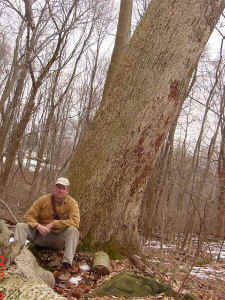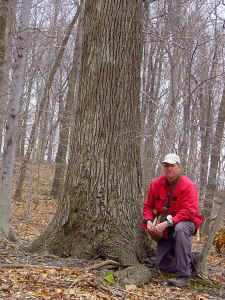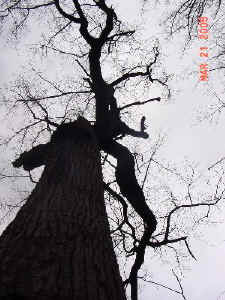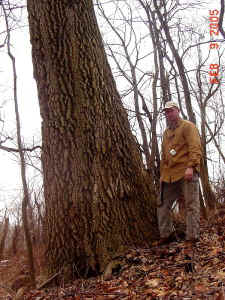| Our Lady of Angels Convent,
Sisters
of St. Francis of Philadelphia, PA |
wad-@comcast.net |
| Mar
21, 2005 14:51 PST |
ENTS.
Location: Aston township, Delaware county, Pa
elevation 200-310 above sea level.
Soil type: Rocky red clay, and other places with granite
outcropping and loam.
PH level 4.5-5.5
This area is a small piece of Piedmont that borders the costal
plain. The Sisters of St Francis of Philadelphia came to this
site in 1873 to start a convent. The property has grown to 280
acres, of which much has remained open space. It is now
surrounded by sprawl and development. Much of the land was
farmed early on, but some areas that were too steep, or too
rocky, avoided the farmers plow.
Five sources
of headwater for the Chester creek originate on this property
via natural springs. In the areas that were not farmed, the
forest floor is covered in spring with many native plants like
trout lilly, cutleaved toothwort, spring beauty, may apple,
blood root, and others. The next layer is comprised of mostly
spicebush due to the whitetail deer, but maple and arrowwood
viburnums, low bush blueberry, native azalea, mountain laurel,
chokecherry, and american holly are present. The understory
trees consist of dogwood, black cherry, ironwood, and hawthorne
among some others. Invasive non native plants are a real threat
to our forest, and war is waged daily on these pests. Today I
found Mahonia bealii growing in the woods. Japanese knotweed is
by far the most damaging and hardest to control.
|

Bitternut hickory 10.8cbh x 111.5'
This tree is nominated for the Pennsylvania state
champion tree list. It is an old wounded giant, with two
of the major branches missing. I took the photo with the
timer.
|

Mockernut hickory 8.7cbh x
117.6' This tree is in great shape and still has potential
to grow. I took the photo with the timer.
|

Sycamore 15.9cbh x 118.9' This tree sits in a
draw on the same north facing slope as the poplar above. It grows within 30
feet of an old springhouse. All of which is in the middle of the woods now. I
took the photo.
|
The large
trees on the property are quite diverse. Black, red, white,
chestnut, post, and pin oaks. Bitternut, mockernut, pignut,
shagbark and shellbark hickory. Red and silver maples. Chestnut,
sour gum, elm, green and white ash. Black, pin, and bird cherry.
Beech, sycamore and poplar of course. It is a nice patch of
ground that we hope to preserve. I am the grounds manager for
the property, and it is alot of work.

Tulip poplar 15.8cbh x
137.5' This is another wounded giant. It is missing a
couple of major limbs, but seems to be in good shape. I am
looking forward to watching this tree make 150'. It sits
on a north facing slope about an 1/8 of a mile from a
medium size creek. I took the photo, the hat is for
reference. The next photo is of the canopy.
|

Tulip poplar canopy |

White ash 15.2cbh x 91.7' Although this is not
the one used in the rucker index, it made a better photo. Sitting on a
different north facing slope, this ash is badly damaged. I took the photo with
the timer.
|
Here is a list of the measured trees. All done with the
rangefinder/clinometer method.
Black cherry 8.0cbh
x 79'
White ash 15.2cbh
x 91.7'
White ash 14.1cbh
x 103.4'
White ash 10.1cbh
x 112.1'R
Tulip poplar 11.0cbh
x 121.4'
Tulip poplar 11.1cbh
x 112.2'
Tulip poplar 15.8cbh
x 137.5' "soopa doopa" R
Tulip poplar 11.3cbh
x 122.4'
Tulip poplar 12.0cbh
x 125.2'
Black oak 10.9cbh
x 110.7' R
Black oak 12.3cbh
x 91.5'
Black oak 11.3cbh
x 93.0'
Black oak 13.1cbh
x 106.3'
Red oak 12.5cbh
x 115.8' R
Red oak 14.6cbh
x 102.5' new tree to me today!
Red oak 10.9cbh
x 101.1'
Red oak 10.1cbh
x 102.4'
Red oak 10.2cbh
x 106.6'
Dead red oak 13.7cbh
Sour gum 8.2cbh
x 96.4' (Nyssa sylvatica)
Mockernut hickory 8.7cbh
x 117.6' R
Mockernut hickory 8.2cbh
x 110.2'
Beech 10.4cbh
x 98.4'
Beech 10.4cbh
x 95.4'
White oak 12.7cbh
x 106.0' R
White oak 12.2cbh
x 72.2'
White oak 13.9cbh
x 96.2'
Bitternut hickory 10.8cbh
x 111.5' R
Shagbark hickory 7.8cbh
x 93.0'
Pignut hickory 7.6cbh
x 115.9' R
Red maple 7.7cbh
x 82.7'
Dead pignut hickory 11.3cbh
Sycamore 15.9cbh
x 118.9' R
Chestnut oak 10.8cbh
x 84.4' very rocky north facing slope
Shellbark hickory 7.9cbh
x 105.5 R
That gives me a rucker index(R) of: 1151.5/10= 115.2'
Should easily reach 130 someday.
Scott Wade
|
| RE:
Rucker/trip report from SE Pa. |
Dale
J. Luthringer |
| Mar
21, 2005 15:58 PST |
Scott,
Outstanding finds! You certainly have some fat trees down there.
I'm
very glad to see your using the rangefinder/clinometer method.
Now I
can get to work updating our 12x100 files. Will's been saying
there's
plenty of them down your way. I'm afraid this is going to be a
regular
thing now. That's 8 more trees for the PA 12x100 club!
The pignut is the tallest on record so far for PA, although I
only have
a few pignuts in my database. Great stuff.
I've got a few questions though. What do you call that ~280 acre
site
in Ashton Township? Sisters of St. Frances?
Are any of your trees doubles? Your 15.2ft CBH white ash and
15.8ft CBH
tulip are impressive.
The mockernut and shellbark hickory are the first we've recorded
so far
in PA using ENTS methods. I just haven't got into any up in my
neck of
the woods. We don't have any post/pin oaks or pin cherry
recorded for
the state yet either. Sure would be nice to get some stats on
them too.
Looks like Philly is assuming its rightful place in our tall/big
tree
stats!
Dale
|
| RE:
Rucker/trip report from SE Pa. |
wad-@comcast.net |
| Mar
21, 2005 16:52 PST |
Dale,
ENTS
The sites name is Our Lady of Angels Convent in Aston, Pa 19014.
Funny thing, it was named Ashton originally, but is is Aston
now.
None of the trees are doubles or coppices, they are all in the
woods, or used to be in the woods.
We have a
couple pin oaks I can measure, but pin cherry will never impress
you as it fizzles out under competition. The bird cherry gets
big, but it is introduced. American forests does recognize it
though as being naturalized.
There is another site in Chester county that has alot of hickory
that I hope to get to this spring. Did you notice there weren't
any evergreens? Not too many around here that are native (read
not planted) Thanks for the comments.
Scott
|
| Re:
Rucker/trip report from SE Pa. |
Michele
Wilson |
| Mar
25, 2005 20:55 PST |
I really enjoy reading through the vertical layers. Thanks,
Scott. Jess is really good at that, too, if I'm remembering the
emailers correctly, and some others on this list. A few years
ago, I started getting even more detailed with stand information
in this way when writing management plans, my clients seem to
enjoy it, and reading how others do it sort of serves as a
refresher course every now and then...and it certainly helps me
to picture all those wonderful places that all of you have been
to that I haven't been to yet.
Michele
|
|